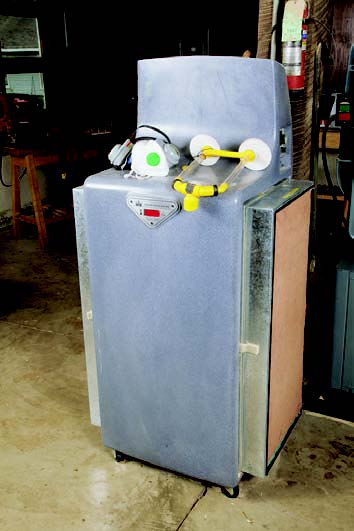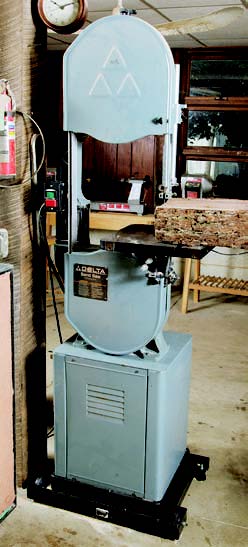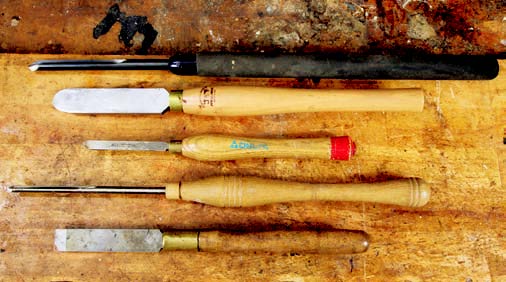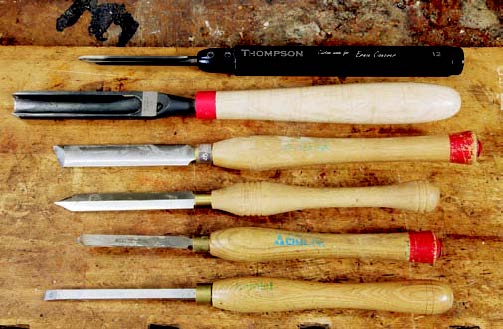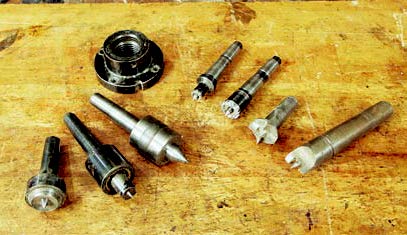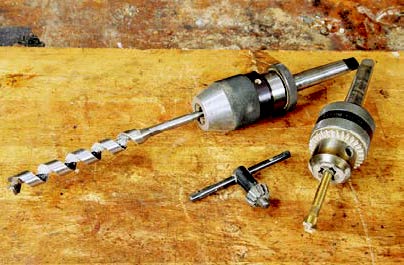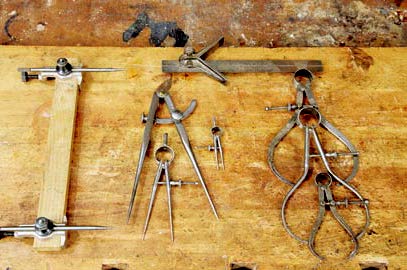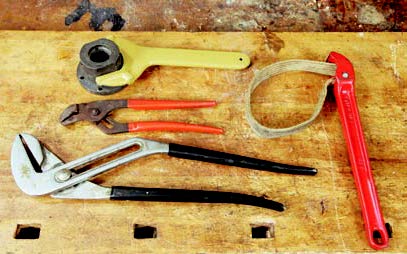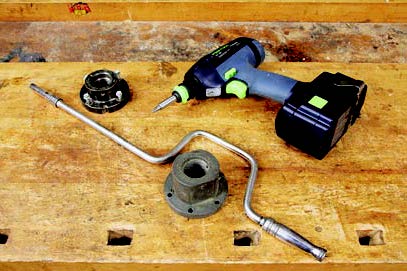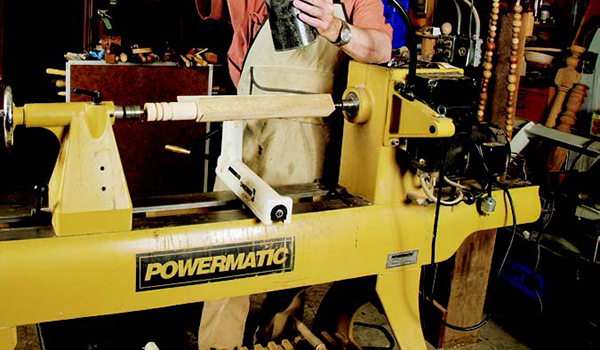
If you’re thinking of getting started in woodturning, here are some great guidelines. Our expert breaks down the “must-have” tools from the “nice to have” and even includes a few of his “dream shop” favorites.
A frequent series of questions at the end of any of my classes or lectures concerns setting up a turning shop. Turning is a special branch of the woodworking tree, which requires unique skills and equipment. With that in mind, here are some thoughts (and a quick outline) dealing with what a person needs in terms of the space and tools to become an effective turner.
Space and Tools Needed
Not a lot of space is needed for a turning shop. As little as 8′ by 8′ will do. Into this 64 square feet you need to fit the basic essentials of a lathe, grinder and buffer — the latter being to sharpen your tools. I do not want to get into what lathe you should buy, because that is a discussion in itself. I will say that if you only want to turn furniture parts you need 30″ between centers, but swing and spindle diameter do not matter very much. It is the opposite if you want to turn bowls. You don’t need much distance between centers, but swing and spindle diameter are very important. You need at least 12″ of swing and a minimum of a 1″ spindle for turning large, heavy bowls.
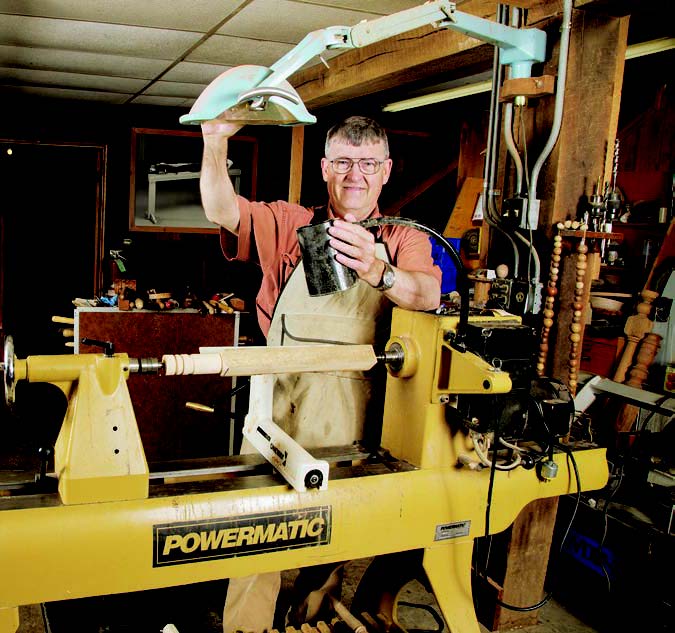
Lighting is very important, and some sort of gooseneck lamp that can be positioned anywhere over the lathe bed is close to a necessity. Dust is hazardous, so a dust mask of some sort is an absolute necessity. A minimum is a paper mask that can be purchased at automotive stores for bodywork. Better is a respirator with paper or even charcoal filters.
An air filtration unit, is a great investment. It filters all the air in my shop of fine dust and VOCs every five minutes.
You will also need a workbench and some storage, but these are easily built yourself. The bench does not have to be fancy, just a solid, level surface with an inexpensive vise. Drawers and cupboards are the best storage because they keep dust at bay.
Once your wallet has absorbed these items, you will want a band saw to cut billets and bowl blanks. The height of cut is much more important in a turning shop band saw than the throat opening (distance from the blade to the support). You want at least a 4″ depth of cut, with 6″ to 10″ being desirable. A plug-in electric drill is good for drilling holes to mount work on faceplates and to drive a mandrel for sanding. If you turn a lot of bowls you might start dreaming about adding a chainsaw to your arsenal, but in the short run you can buy bowl blanks.
Turning Tools
You will need some turning tools for spindle and bowl turning. Sets of tools have great pitfalls. While they seem thrifty, they tend to have a mediocre spindle gouge, a skew that is too narrow for beginners, a low quality parting tool and redundant scrapers — on reflection, I cannot think of any good points.
You are far better off acquiring good quality high speed steel (HSS) tools, individually, as you can afford them. There are other options on the market, but for starting out, HSS represents the very best bang for the buck.
Lathe Accoutrements
Beyond the lathe, you will need some bits and pieces. Most lathes come with a faceplate, a drive center and a tailstock center. While the faceplate is generally fine, the centers are often barely adequate. You will want to replace them in the long run. For the headstock I like Steb centers rather than the normal 2- or 4-prong drive center.
Metalworking supply houses offer 60 different live centers that are cheaper (but of better quality) than most offered by woodturning purveyors. I use such centers for everything but paper-jointed split turnings, which require a cup center. All lathes come with a tool-rest or two, but you may want to buy a longer one for spindles and some curved ones if you plan to focus on bowl turning. There are a number of third party suppliers of reasonably priced, high quality rests.
A 1/2″ drill chuck is very handy for drilling holes on center and can be mounted in the headstock or tailstock. Top quality keyless examples can be had for $35, with keyed types going for much less. The final holding device you will eventually want, especially if you turn bowls or hollow forms, is a four-jaw scroll chuck. I do recommend that you learn to turn well with faceplates, drive and live centers before investing in this tool.
Measuring and Layout Tools
Although I prefer a folding wood ruler, a tape measure will work fine. These tools are so cheap today I think you should buy both. To start with, drawing lines between the corners of square spindle billets will find center. Eventually, you will want to purchase a center finder. Inexpensive plastic examples abound, but I like a V-shaped attachment for my combination square. Dividers are handy for laying out circles, stepping off distances and finding the center of a circle. Calipers are indispensable in duplicating spindles and keeping the walls of bowls uniform.
You will want a center punch for indenting the centers of spindles for quick and accurate chucking. A large nail or a standard center punch will do fine, but an automatic center punch is very handy, ranging in price from $10 (very serviceable) to $39 for a Starrett (your grandchildren will use it).
A large pair of vise grips, a large wrench or a plumber’s strap wrench are handy for removing faceplates from the lathe. Work is attached to faceplates with screws, and normal screwdrivers do not afford enough leverage to drive them handily. Therefore, a screw gun or a crank-like device called a speeder is a welcome addition to the shop. My students seldom strip screws with the speeder; they do, regularly, with a screw gun. I use hex head sheet metal screws because of the positive drive I get with either a speeder or a screw gun.
The Total Shop
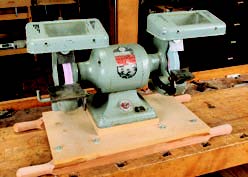
If you find turning is just your cup of tea, you will want to consider adding a dust hood or shroud to suck up chips and dust while turning. From this short list of “must-have” and “nice to have” tools, the sky is the limit!
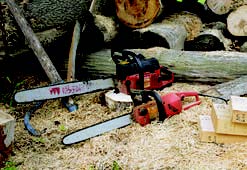
Turners are much like golfers: you can play with a few clubs, but most need a cart to carry the bag. This is to say that you might very well be planning a new addition to the shop!
